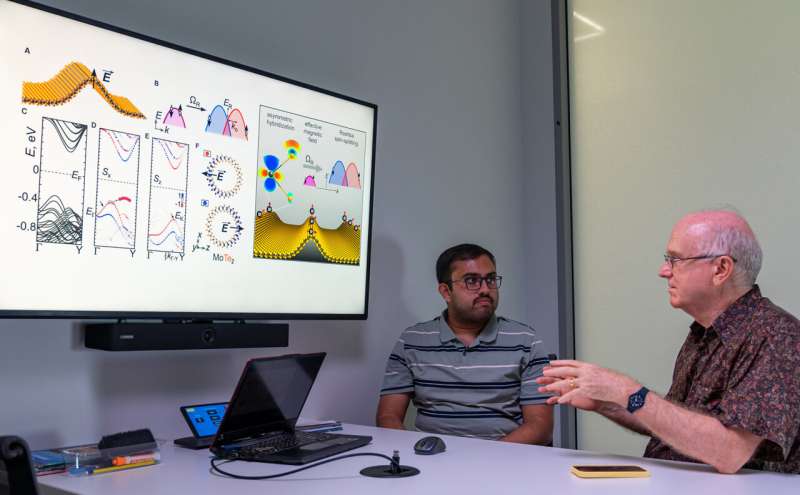Wrinkles can be an asset—especially for next-generation electronics. Rice University scientists have discovered that tiny creases in two-dimensional materials can control electrons’ spin with record precision, opening the path to ultracompact, energy-efficient electronic devices.
If most devices today use the charge of electrons flowing through silicon to process and encode information, future computing may instead harness spin—a quantum property of electrons that takes on either an “up” or “down” value. Computing with spin could overcome the limitations of current silicon-based technology, reducing the energy footprint of devices and data centers at a moment when computing-driven energy use is soaring globally.
However, spintronics has to contend with a major challenge: Information encoded in spin is quick to decay and can be lost when the electrons in a material scatter and collide with atoms.
In a study published in the journal Matter, Rice materials scientists have reported that bending atomically thin layers of materials like molybdenum ditelluride gives rise to a unique spin texture called persistent spin helix (PSH), which can preserve a spin state even in scattering collisions.
“In typical materials, spin is tied to electron momentum, so changing direction alters spin, whereas in materials with PSH states, spin state remains fixed,” said Sunny Gupta, a Rice alumnus and postdoctoral associate who is a first author on the study. “Very few materials in nature can host PSH, making it rare, and until now, hard to fabricate.”
The research team led by materials scientist Boris Yakobson hypothesized that wrinkles in 2D materials could be a way to control electron spin states: When a 2D material is bent, the top side of the sheet stretches while the bottom side gets compressed. This uneven strain causes positive and negative charges to shift slightly relative to one another, producing an internal electric field⎯-a phenomenon known as flexoelectric polarization.

Electron spins in a bent 2D material interact with the flexoelectric effect created by the curvature of the sheet, which causes spin-up and spin-down electrons to split into distinct bands or regions. The higher the curvature, the stronger this interaction is. At its highest, the curved regions produce such a strong effect that the electrons’ spins exhibit the desired helix shape and flip between “up” and “down” states while passing only about 1 nanometer.
“Undulations are common in 2D materials, appearing as wrinkles or self-sustained hairpinlike loops when folded—creating regions with extremely high curvature,” Gupta said. “We demonstrate that in such hairpin folds in molybdenum ditelluride, PSH states can achieve a spin-precession length of about 1 nanometer—the shortest reported to date.”
A short precession length means spintronic devices can be that much more compact.
“This work establishes controlled bending of 2D materials as a strategy for engineering distinct and exotic field profiles,” said Yakobson, Rice’s Karl F. Hasselmann Professor of Materials Science and Nanoengineering and the corresponding author on the study. “A humble ‘mechanical pinch,’ which occurs easily in 2D materials, splits the spins and induces PSH texture.”
Gupta noted that the starting premise of the investigation was somewhat counterintuitive, since “quantum behaviors and elastic mechanics are two different areas of physics that rarely intersect.”
“Here we showed that not only do macroscopic changes in the geometry or shape of 2D materials have an impact on the deep quantum-relativistic interaction between electron spin and nuclei, but also that this effect can be harnessed to create exotic spin textures for novel spintronics,” he said.
More information:
Sunny Gupta et al, Mechanical crease in 2D materials—A platform for large spin splitting and persistent spin helix, Matter (2025). DOI: 10.1016/j.matt.2025.102378
Citation:
Wrinkles in atomically thin materials unlock ultraefficient electronics (2025, August 21)
retrieved 21 August 2025
from
This document is subject to copyright. Apart from any fair dealing for the purpose of private study or research, no
part may be reproduced without the written permission. The content is provided for information purposes only.

